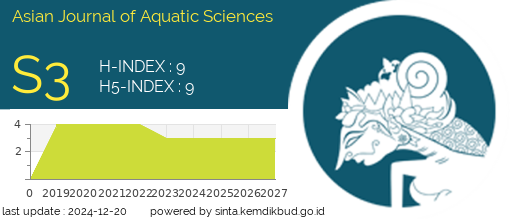EDIBLE FILM CHARACTERISTICS WITH CARRAGEENAN (Eucheuma cottonii) FLOUR EXTRACTED WITH DIFFERENT BASE SOLVENTS
DOI:
https://doi.org/10.31258/ajoas.8.2.285-290Keywords:
extraction, Eucheuma cottonii, edible film, carrageenan, Base solventAbstract
Edible film is a primary packaging in the form of a thin layer and functions as a coating for food ingredients, which can be made from hydrocolloid compounds. Carrageenan polysaccharide is one of the hydrocolloids used to make edible films because it produces strong gel properties. Eucheuma cottonii is a seaweed that produces relatively high levels of kappa carrageenan, namely around 50%. This research aims to determine the physical and mechanical characteristics of edible film with carrageenan flour from E. cottonii extracted with different base solvents. The research method was carried out experimentally with an experimental design, namely a non-factorial Completely Randomized Design (CRD) with three levels of treatment, namely differences in carrageenan flour extracted with KOH, NaOH and Ca(OH)2 solvents. The parameters of this research are physical and mechanical analysis of edible film including testing tensile strength, thickness, percent elongation, and water vapor transmission rate. The research results showed that the best results were in the treatment of carrageenan flour extracted with KOH solvent, where the physical and mechanical analysis of the edible film showed a tensile strength value of 9.49±0.50 MPa, a thickness of 0.03±0.003 mm, a water vapor transmission rate of 30.13±0.41 g/m2/day, and a percent elongation 9.86±0.41%.
Downloads
References
1. Moses, J., Anandhakumar, R., & Shanmugam, M. Effect of Alkaline Treatment on the Sulfate Content and Quality of Semi-Refined Carrageenan Prepared from Seaweed Kappaphycus alvarezii Doty (Doty) Farmed in Indian waters. African Journal of Biotechnology, 2015; 14(18): 1548-1589.
2. Herliany, N., Santoso, E., & Salamah, E. Karakteristik Biofilm Berbahan Dasar Karaginan. Jurnal akuatika, 2013; 4(1): 10-20.
3. Nurmilla, A., & Aprillia, H. Karakteristik Edible Film Berbahan Dasar Ekstrak Karagenan dari Alga Merah (E. spinosum). Jurnal Riset Farmasi, 2021; 24-32.
4. Rusli, A., Metusalach, S., & Tahir, M.M. Karakterisasi Edible Film Karagenan dengan Pemlastis Gliserol. Jurnal Pengolahan Hasil Perikanan Indonesia, 2017; 20(2): 219-229.
5. Fardhyanti, D.S., & Julianur, S.S. Karakterisasi Edible Film Berbahan Dasar Ekstrak Karagenan Dari Alga Merah (Eucheuma cottonii). Jurnal Bahan Alam Terbarukan, 2016; 4(2): 68-73.
6. [ASTM]. Standard Test Methods for Tension Testing of Metallic Materials. E8/E8M-13a. Annual Book of ASTM. ASTM International. 2013.
7. Saputro, B.W., Dewi, E.N., & Susanto, E. Karakteristik Edible film dari Tepung Semirefined Karaginan dengan Penambahan Tepung Tapioka dan Gliserol. Jurnal Pengolahan dan Biokteknologi Hasil Perikanan, 2017; 6(2): 2442-4.
8. Setiani, W., Sudiarti, T., & Rahmidar, L. Preparasi dan Karakterisasi Edible Film dari Poliblend Pati Sukun-Kitosan. Valensi, 2013; 3(2) : 100-109.
9. Xu, Y.X., Kim, K.M., Hanna, M.A., & Nag, D. Chitosan-starch composite film: preparation and characterization. Industrial Crops and Products, 2005; 21: 185–192.
10. Dhall, R.K. Application of Edible Films and Coatings on Fruits and Vegetables, in Garcia, M.P.M., Gomez-Guillen, M.C., Lopez-Caballero, M.E., & Barbosa-Canovas, G.V. Edible Films and Coatings: Fundamentals and Applications. CRS Press, New York. 2017.
11. Sirait, P.S., Diharmi, A., Edison, E., & Azmi, H. Effect of Different Types of Base Solution on Physico-Chemical Characteristics of Eucheuma cottonii Carrageenan Flour. BIO Web of Conferences, 2024; 136, p. 02009
12. Ega, La., Lopulalan, C.G.C., & Meiyasa, F. Kajian Mutu Karaginan Rumput Laut Eucheuma cottonii berdasarkan Sifat Fisiko-Kimia pada Tingkat Konsentrasi Kalium Hidroksida (KOH) yang Berbeda. Jurnal Aplikasi Teknologi Pangan, 2016; 5(2): 38-44
13. Syahputra, S.Y., Agustina, R., & Putra, B.S. Kuat Tarik Edible Film Bahan Dasar Pati Sagu Dengan Penambahan Sorbitol. Jurnal Ilmiah Mahasiswa Pertanian, 2022; 7(7): 464-471.
14. [JIS] Japanese Industrial Standard 1707. Japanese Standards Association. Japan. 1997.
15. Ariska, R.E., & Suyatno, S. Pengaruh Konsentrasi Karagenan terhadap Sifat Fisik dan Mekanik Edible Film dari Pati Bonggol Pisang dan Karagenan dengan Plasticizer Gliserol. Seminar Nasional Kimia Jurusan Kimia FMIPA Universitas Negeri Surabaya. Surabaya, 3-4 Oktober 2015. 2015.
16. Wulandari, N.S., Pramesti, R., & Susanto, A.B. Analisis Parameter Fisika dan Kimia Karaginan Kappaphycus alvarezii Doty 1985 (Florideophyceae: Solieriaceae) dengan Variasi Ekstraksi dari Perairan Bluto. Journal of Marine Research, 2019; 8(4): 409- 415.
17. Gozali, T., Wijaya, W.P., & Rengganis, M.I. Pengaruh Konsentrasi CMC dan Konsetrasi Gliserol terhadap Karakteristik Edible Packaging Kopi Instan dari Pati Kacang Hijau (Vigna radiata L.). Pasundan Food Technology Journal, 2020; 7(1):1-9.
18. Fahlevi, R., Santoso, B., & Priyatno, G. Karakteristik Edible Film Fungsional Pati Ganyong dengan Penambahan Filtrat Gambir (Uncaria gambir Roxb) dan Ekstrak Kenikir (Cosmos caudatus). Seminar Nasional Lahan Suboptimal. Palembang, 4-5 September 2019. 2019.
Downloads
Published
Issue
Section
License
Copyright (c) 2025 Putriana Sari Sirait, Andarini Diharmi, Heriza Azmi (Author)

This work is licensed under a Creative Commons Attribution 4.0 International License.







